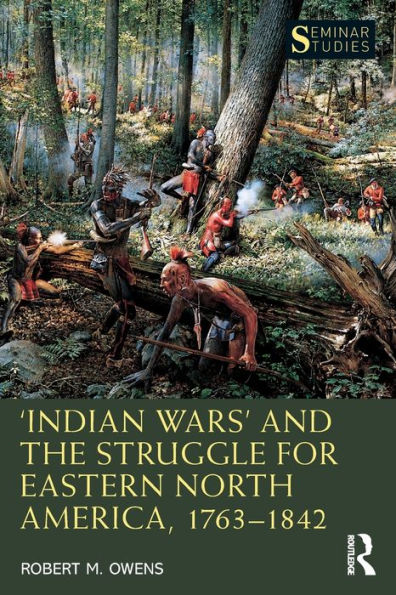
'Indian Wars' and the Struggle for Eastern North America, 1763-1842
194
'Indian Wars' and the Struggle for Eastern North America, 1763-1842
194Paperback
-
PICK UP IN STORECheck Availability at Nearby Stores
Available within 2 business hours
Related collections and offers
Overview
The story begins in the wake of the Seven Years’ War and ends with the period of Indian Removal and the conclusion of the Second Seminole War in 1842. Anglo-Americans had feared multi-tribal coalitions since the 1670s and would continue to do so into the early nineteenth century, long after there was a credible threat, due to the fear of slave rebels joining the Indians. By focusing on the military and diplomatic history of the topic, the work allows for a broad understanding of American Indians and frontier history, serving as a gateway to the study of Native American history.
This concise and accessible text will appeal to a broad intersection of students in ethnic studies, history, and anthropology.

Product Details
| ISBN-13: | 9780367492052 |
|---|---|
| Publisher: | Taylor & Francis |
| Publication date: | 11/18/2020 |
| Series: | Seminar Studies |
| Pages: | 194 |
| Product dimensions: | 6.00(w) x 9.00(h) x (d) |
About the Author
Table of Contents
List of Figures ix
Chronology x
Who's Who xvii
Glossary xxx
Map xxxiv
Part I Analysis and Assessment 1
Introduction: Clashing Cultures 3
Competition and Conquest: How Europeans Saw America 3
For the Love of God 4
Gender and Colonization 4
To be "Civilized" 5
Forming an Imperfect Union 9
The Tyranny of Terminology 10
1 Britain's Tenuous Empire 12
The European Contest for North America 12
Penny-wise and Pound-foolish: Pontiac's War 14
Efforts in Diplomacy 19
Bleeding Pennsylvania 21
War's End? 23
Murder and Real Estate: Lord Dunmore's War 26
2 Revolting Americans 29
Many Problems and Few Solutions 29
Factionalism among the Cherokees 30
The British-Indian Alliance Stumbles in the North 33
Southern Discomfort 35
Violence Surges in the West 42
3 Confederations 46
Patriotic Paternalism 48
Creeks, Cherokees, and Southerners 53
Elusive Peace on the Frontier 58
4 Dueling Unions 63
Harmar's Campaign 63
The St, Clair Disaster 65
Wayne Takes Command 70
The Treaty of Greenville 76
Bowles Bows Out 78
5 Jeffersonians and Indians 81
Jefferson's Indian Land Policy 81
Tecumseh: The Greatest Pan-Indianist 84
A Civil War Among the Creeks 91
Americans Take Aim at Canada 92
Red Sticks and Old Hickory 95
6 Man Wars in the Age of Jackson 100
The Question of Florida 100
The First Seminole War 102
The Black Hawk War 106
The Second Seminole War 109
Conclusion: Making Sense of History 116
Indian Wars in Memory 116
"Heroes" Need "Villains" 117
Professors and Producers 118
Part II Documents 121
1 George Croghan at Fort Pitt to Sir William Johnson, 31 March 1762 123
2 Sir William Johnson at Johnson Hall, 18 March 1763, to Gen. Jeffery Amherst 124
3 Speech of Pontiac, 27 April 1763 124
4 Proclamation of Gov. Josiah Martin, North Carolina, 18 May 1774 125
5 Virginia Gazette, 17 August 1776 125
6 Virginia Gazette, 14 September 1776 126
7 Virginia Gazette, 30 May 1777 126
8 Extract of a letter from Silver Bluff, 28 October 1779 126
9 The Royal South Carolina Gazette, 9 May 1782 127
10 Alexander McGillivray at Little Tallassee, 15 September 1788, to Richard Winn, Andrew Pickens, and George Mathews, Commissioners for treating with the Southern Nations of Indians 127
11 Richard Winn, Andrew Pickens, George Mathews, to Alexander McGillivray, Esq. and the head men and warriors of the Creek nation. Hopewell on Keowee, 28 November 1788 128
12 Kentucky Gazette, 12 April 1788 130
13 General Joseph Martin, Agent to Cherokees, to Sec. War Knox, 2 February 1789 130
14 "For the Indian Department," Boston Gazette, 2 January 1792 132
15 Sec. of War Knox to Gov. William Blount, Southwest Territory, 31 January 1792 133
16 Hanging Maw's Talk, Kentucky Gazette, 17 November 1792 135
17 Memorial from the Widow of a Cherokee Chief, submitted to Congress, 17 January 1797 136
18 Piomingo in the Chickasaw Nation to General James Robertson, 17 June 1793 137
19 Kentucky Gazette, 1 September 1800, story from Savannah, Georgia 139
20 Pres. Jefferson to Gov. Harrison, 27 February 1803 139
21 Tecumseh's speech to Gov. Harrison, 20 August 1810 141
22 Lydia Bacon's journal, 30 November 1811 143
23 Indian Removal Act of 1830 144
24 Baltimore Patriot, 21 July 1831, "The Indian Disturbances" 146
25 Pittsfield Sun (MA), 4 August 1831, from the St. Louis Beacon 146
26 New Hampshire Sentinel, 11 February 1836, "A second Tecumseh" 147
27 The Floridian, 21 May 1836 147
Guide to Further Reading 148
References 153
Index 158
